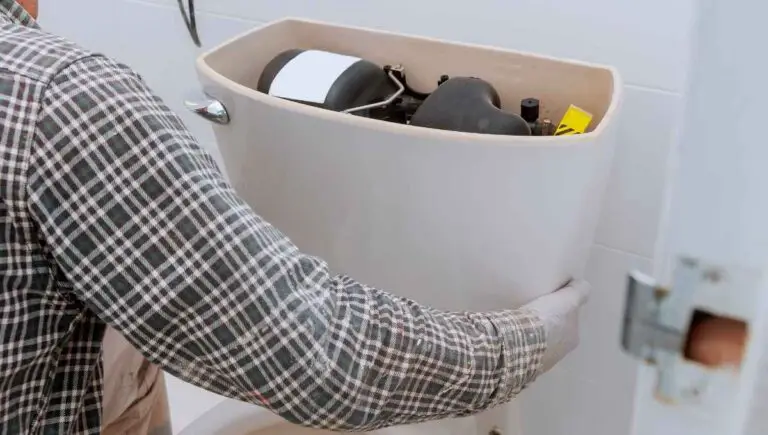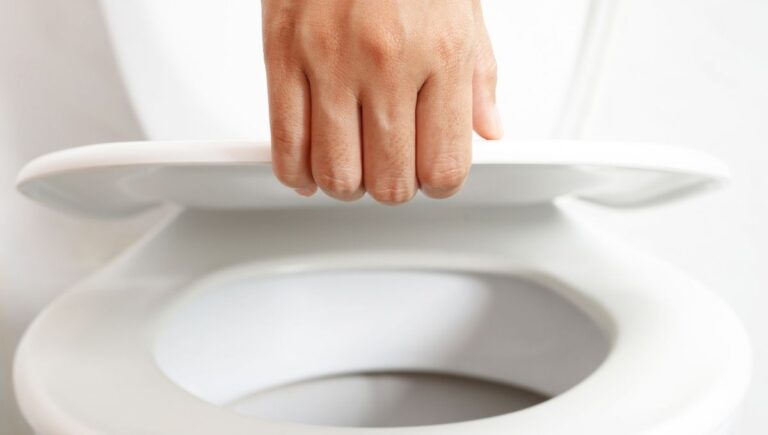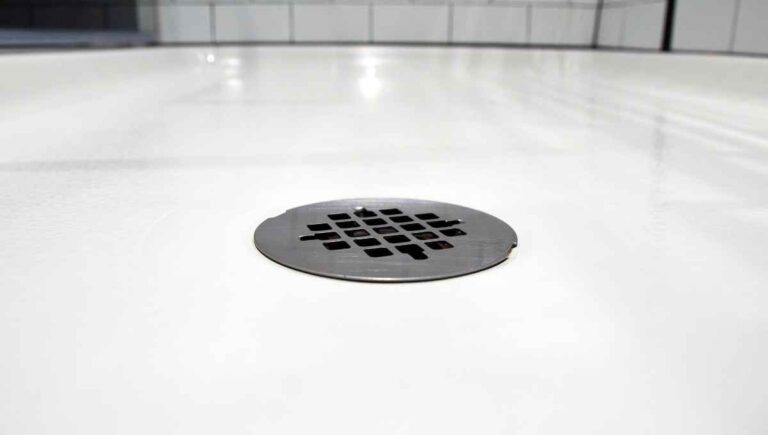Do Bathtubs Need a Vent? (What Could Happen Without One)

Installing a new bathtub can be a complicated affair. Even without all the piping, you need to make sure your bathtub is following your state’s local building codes. This can easily become a complex issue. Do bathtubs need to have a vent in order to be compliant though?
All bathtubs need to have vents in order to operate properly. Bathtubs that do not have vents could release strong smelling and potentially dangerous fumes. Bathtubs without vents also drain slowly and may make bubbling or gurgling noises.
Clearly, a bathtub vent is crucial to a properly functioning drainage system and can’t be skipped over. They don’t need to be a cause for stress, though.
It’s not as complex as you might think, and it’s very possible to learn about installing vents, P-traps, tub overflows, and how these fixtures affect your bathtub.
This post contains affiliate links. This means Household Blogger may earn a commission should you make a purchase using any of our links. Please refer to our full affiliate disclosure policy for full details.
Here’s a Quick Pro Tip!
Bathtubs and other bathroom amenities do require a vent, but all regulated bathtubs will have one installed. If you’re having plumbing issues and you’re not sure if it’s the vent, chances are it’s a clogging issue instead!
Here are some great options for getting your bathtub drain back in working order:
1. Drain Cleaner Sticks – It may be gross, but it’ll get the job done easily!
2. Electric Drain Cleaner – For really, really bad clogs.
3. Green Gobbler Drain Clog Remover – For anyone who doesn’t want to get their hands dirty.
What Bathtub Vents Are And How They Help
It’s one thing to know that bathtub vents are important. It’s a completely different thing to understand what bathtub vents are and what they can do for your bathtub drainage.
These fixtures are key to installing a tub, so how do they work?
What Is a Bathtub Vent?
A bathtub vent is a type of pipe attached to the main drain line. It is generally positioned vertically and allows toxic gases to escape, which helps keep proper pressure within the pipe system. Some bathtub vents (known as wet vents) combine water transportation and gas venting.
The majority of homes in the US will have vent systems set up for every bathroom fixture, not just the bathtub.
This is because there are building codes that require bathroom fixtures to have vents.
Bathtub vents aren’t optional for a functional, efficient, and safe tub. Without a vent, the toxic gases can build up within the pipes and escape into the surrounding air.
Why Does a Bathtub Need a Vent?
Bathtub vents are needed because they are used to prevent sewage gas buildup and to maintain the correct pressure in the drainage pipes. Tubs, as well as other fixtures attached to the sewage system, need vents to avoid issues with clogging, toxic fumes, and inefficient draining.
It’s obviously not a great idea to skip out on a bathtub vent for safety reasons, but it’s also against code in many states in the US.
For those bathroom DIYers out there, don’t skip out on vents just because you think you can deal with not having them.
If you don’t want to fit an extra pipeline, you can try looking into wet venting. Wet venting will let one pipe transfer water and vent at the same time.
What Is a P-Trap?
A P-trap is a kind of pipe shape that works to block out sewage gases by holding water. It also stops water from siphoning out of the sewage trap. It’s called a P-trap because of its shape, which is reminiscent of the letter P.
The shape of the P-trap is actually what lets it function, hence why it’s named after the shape. A P-trap is laid out with a divot making a “P” shape facing downwards.
This small divot is where the gas-blocking water is held.
P-traps work in tandem with vents to keep sewage gases from doing any harm, and vents are always placed near the P-trap.
Blocked gases can then escape through the vent without escaping into your home!
Does a Shower Tub Need a Vent?
Every bathroom fixture needs a vent if it is connected to the sewage lines, including shower tubs. Vents keep the drainage system working properly without releasing bad odors or making gurgling noises. They also help with efficient draining and maintaining pressure in the pipes.
The “bad odor” that a shower tub would release if it doesn’t have a vent is actually sewage gas. Since sewage gas can contain methane and other harmful elements, it’s dangerous to not have a vent in a shower tub.
Essentially, you need to have a vent if the fixture is connected to sewage in some way. Otherwise, you’re exposing yourself to, well, sewage!
You might also enjoy our post on If Bathroom Sinks Need a Vent
Does a Tub Overflow Act As a Vent?
A tub overflow can’t act as a vent since it serves a completely different purpose. A tub overflow holds excess water before it spills out. Alternatively, a vent prevents sewage gas from escaping into your home with the help of a P-trap.
To remember the difference, look at the names. A tub overflow prevents an overflow of water by holding the excess.
A vent literally vents sewage gas from the drainage system. It’s important to have both installed so that you have all of your bases covered.
Having a tub overflow can’t save you from sewage gas seeping into your home. It can, however, help prevent annoying bathroom floods!
You might also enjoy our post on How Much it Costs to Fix a Cracked Bathtub
Are Toilets And Tubs Self Vented?
Toilets and tubs aren’t self vented, but building codes in many states require vents to be installed in every bathroom fixture that is connected to the sewage lines. This means that pre-built toilets and tubs likely have a vent installed already.
You need to add a vent in yourself if it is not already present or if you’re installing a new toilet or tub.
It would be a big mistake to think that toilets and tubs are self vented, or that they can do without a vent. Vents don’t just help with keeping your drain working efficiently, but they also guard against dangerous fumes.
A toilet or tub that doesn’t have a vent will release strong-smelling odors that are actually a product of sewage gas.
The human body can’t self-vent sewage gases either, so it’s definitely worth it to add a vent to your toilets and tubs.
Do I Need To Add Venting If I Want To Convert My Tub To a Shower?
If venting is already present in your bathtub draining system, then there is no need to add extra venting to a combined bathtub and shower. The conversion from a bathtub to a shower may or may not alter the drainage system at all, since both bathtubs and showers require many of the same drains and pipes.
A shower and bathtub will probably be using the same drain line. You don’t need twice the venting power just because you’ve converted your tub to a shower, so a vent that is already present can be used for both!
This goes for bathtubs that are replaced with walk-in showers and bathtubs that are converted to bathtub-shower combos.
Either way, if it’s using the same drainage system as before, there’s no need to add an extra vent.
Ways To Install Bathtub Vents And Details On Installation
The actual installation of a bathtub vent is more complicated than knowing what the vent is. It’s important to get this part right since vents can affect your health and sanitation.
Where Do You Vent a Bathtub Drain?
A bathtub drain should have a vent placed between the P-trap under the sink and the pipe leading to the sewer lines. It’s important to keep the vent close to the P-trap in order to allow both to function as intended.
The exact distance from the P-trap that the vent should be placed depends on the size of the P-trap.
Based on the state you live in, there are different regulations for how far the vent is allowed to be from the trap.
For a building that’s up to code, you need to follow the specific regulations where you live and for the size of trap you have.
For example, in the residential code for Kansas, a 3-inch diameter trap is required to be 12 feet from the vent.
You might also enjoy our post on If You Can Move a Bathtub
Where Should a Plumbing Vent Be Located?
A plumbing vent should be located after the P-trap and before the pipe leading to the sewer lines to be effective. A vent that comes before the P-trap will do nothing to release the gas buildup, while a vent that is too far away from the P-trap will also be dysfunctional.
There is some wiggle room for where the plumbing vent is allowed to be, but for the most part, it’s dictated by building codes in your area.
In the US, individual states can actually have different requirements for where a plumbing vent should be located.
Since there’s really no way to find out what is or isn’t an acceptable location without checking the code, make sure you do your research before you start installing a vent.
What Is Code For Plumbing Vents?
Every state and country has potentially different regulations for where plumbing vents should be placed. Most places in the US require a vent to be included and many states list specific requirements for how far away a vent is allowed to be from the P-trap.
To find out what the code is, you need to research your specific locale.
It’s common for vent distance from P-trap to be dictated by the size of the pipeline/trap. Most building codes and regulations will let you see exactly what the acceptable distance is.
Some of the vent and trap regulations for Kansas are presented in the table below.
MAXIMUM DISTANCE OF FIXTURE TRAP FROM VENT
How Do You Vent a Tub?
Bathtubs can be vented by installing a special pipe known as a vent after the P-trap. There are a number of different types of vents that you can use to vent a tub, but they all ultimately serve the same purpose.
It’s hard to say exactly what kind of vent will work for you without knowing your personal plumbing situation.
That being said, it’s good to look into the different kinds of vents so that you can judge for yourself (or ask a professional for help deciding) which vent is going to be the most practical.
Most vents are dry vents, meaning that they only allow gas to travel through them and not liquid. True vents, revents or auxiliary vents, and loop vents are all types of dry vents.
Vents that do double-duty as water transport and gas vents are known as wet vents.
You might also enjoy our post on How to Keep Shower Curtains From Falling Down
How Do You Vent a Freestanding Tub?
Freestanding tubs can be vented using similar tactics to regular bathtubs. A regular vent pipe can be connected to the main drain line with a T-joint. Multiple vent types and tactics, such as loop venting, reventing, and wet venting are all possible for freestanding bathtubs if the code allows it.
Freestanding bathtubs need to be vented just as much as every other tub, so don’t leave vents out of the picture!
Thankfully, freestanding tubs use many of the same techniques as a normal bathtub would.
The main concern you should have is making sure you understand the building code in your area and you’re following regulations.
Since they’re different everywhere, you need to find the code for your area on venting tubs.
How Do You Choose a Bathtub Vent Cover?
Bathtub plumbing vents don’t need a cover, but vents for the whole bathroom do need one. The most important thing when choosing a bath vent cover is to measure the size of the opening and learn standard floor vent sizing.
Bathroom vent covers come in a multitude of shapes, sizes, and styles.
What style you choose is truly up to personal preference. Making sure that the size of the vent cover matches the size of the opening is the only requirement when selecting a cover, since it just won’t fit otherwise!
Some vent covers prioritize energy efficiency, while other vent covers are decorative and prioritize aesthetics. Again, it’s up to you what you want out of your vent cover.
How Do You Choose a Bathtub Vent Size?
The size of your bathtub’s vent pipe is dependent on building codes and regulations in your area. This means that there are no one-size-fits-all vent sizes, since it varies with the region, the size of your waste stack, and the number of fixtures using the vent.
Choosing a bathtub vent size is really just a matter of researching the code in your area.
Codes can be different for different counties and even cities within a state, so make sure you check your specific locale.
How Far Can a Tub Drain Be From a Vent?
Tub drains have a maximum distance from a vent that depends on building codes in the area. In the US, these codes generally dictate that the maximum distance for a drain is 5-8 feet from the vent.
At the end of the day, the vent needs to be close enough to the drain in order for it to do its job correctly.
But there is some variation in exactly what “close enough” means, which is why building codes are different in different regions.
The most important thing is to check regulations in your area before you try to install anything.
Can a Toilet, Shower, And Sink Share a Vent?
It’s possible for two bathroom fixtures to share a vent, but usually, three are too many to fit with one vent. A common example is for the sink and shower to share a vent, but the toilet to have its own vent. A waste line can be shared by up to 4 fixtures so long as the pipe is 2” wide.
The code for how many fixtures can share a vent or a waste line is variable depending on where you are.
That being said, it’s pretty common for 2 bathroom fixtures to be the maximum fixtures allowed to share one vent.
Can a Tub And Shower Share a Vent?
It’s common for combined tubs and showers to share a vent, but not if they are too far apart. They can also share a waste line even if they are separate fixtures, so long as the waste line is at least two inches in diameter.
In the case that they are separated and far apart, they both need to have a vent and a P-trap.
Sharing a waste line is a no-brainer, and the only real requirement here is that the waste line is big enough to let all the water through.
But the key here is to remember that every individual bathroom fixture will need to have easy access to its own vent.
That means you can have one vent shared by multiple fixtures (called a common vent), but it needs to be close enough to every fixture to function.
Do All Drains Need a Vent?
All drains in a home will need a vent, whether they are drains for a bathtub, shower, toilet, or kitchen sink. This is because any fixture that is connected to the sewage lines has the potential to excrete toxic sewage gas, so a plumbing vent is necessary to vent this gas outside of the home.
Vents play a critical role in keeping dangerous fumes away from your lungs, but they also serve other purposes.
They work in tandem with the P-trap to maintain the appropriate pressure in the pipes, keep things draining quickly, and avoid strange gurgling sounds.
Plus, keeping sewage gas out means you’ll be free from that nasty rotten-egg smell.
Does Every Plumbing Fixture Need a Vent?
Plumbing fixtures in the home will always need a vent. This includes everything from a kitchen sink to a toilet to a bathtub. Since these fixtures are connected to the sewage system, the vents are necessary in order to get rid of sewage gas and dangerous fumes.
Sewage gas doesn’t just smell unpleasant; it can also contain fumes like methane that are unsafe to be inhaled.
Without a vent, you’re running the possibility of these gases escaping right into your house and causing health issues over time.
Does a Plumbing Vent Have To Go Through The Roof?
In most cases, plumbing vents don’t have to go through the roof. It’s possible to put the plumbing vent through a wall instead of a roof, so long as it’s an exterior wall and the vent is higher than the windows.
Roof stacks are a very common type of plumbing vent simply because they’re far away from windows or air conditioning units.
There’s not much point in a plumbing vent if the fumes can just float right back into the house!
You might also enjoy our post on If a Bathtub Drain Can Freeze
Consequences Of Not Having a Vent Pipe
Vent pipes may be a pain to install, but the reason that we need them is quite important. After all, nobody wants their bathroom to smell like sewage waste.
What Happens If a Drain Doesn’t Have a Vent?
Drains that don’t have a vent will experience a number of issues ranging from difficulty draining quickly to strange gurgling noises. Additionally, drains without a vent can start smelling bad because of sewage gas escaping.
As you might expect, not including a vent in your drainage plans will lead to sewage gas leaking into your bathroom.
This can cause health concerns if someone is exposed to sewage gas over time.
Will a Shower Drain Without a Vent?
A shower will drain without a vent, but it will drain much slower than if it has one. Vents help all sorts of bathroom drains remove water efficiently and without releasing toxic gas.
If your shower doesn’t have a vent, you’re likely to be plagued with issues like drain overflows.
It’s not a matter of your drain being a “little slow”, but rather the lack of a vent can completely stop your shower from being usable.
Will a Bathtub Drain Without a Vent?
Although a bathtub will technically drain without a vent, it won’t drain as quickly and can experience difficulties getting rid of water. There may also be pungent smells and gurgling noises while the drain is trying to work.
Ultimately, whether or not a bathtub will technically drain without a vent is beside the point.
Not only will it be incredibly slow, but it can release dangerous fumes into your home and will make loud bubbling sounds.
On top of all that, you’ll likely be stuck with constant overflow problems!
Why Isn’t My Bathtub Draining
There are a number of reasons why your bathtub isn’t draining, but clogging is the most likely cause, especially if your bathtub was working before. If you installed the tub yourself, make sure you have all of the piping correct and you included a vent.
Bathtubs that are clogged because of loose hairs and other debris can usually be fixed pretty quickly and easily with a drain cleaner.
This tool reaches into the drain for you and hooks out all of the stuck hair, hair ties, et cetera.
How Do You Fix Bathtub Vent Issues?
Unless you have experience with plumbing, it’s best to hire a plumber or other professional to help you fix bathtub vent issues. If your only problem is a clogged drain, you can do it yourself with a plumber’s snake.
Before you try any DIY fixes or order your own plumber’s snake, make sure you research exactly what the problem might be and how to use the tools in question.
Once you have that taken care of, you can go ahead and get a professional plumber’s snake.
You might also enjoy our post on How to Get Your Bathtub White Again
Related Questions
Does a Washer Drain Need a Vent?
Every type of drain that connects to the sewage lines, including a washer, needs a vent. Plumbing fixtures all have the potential to allow toxic fumes into your house from the sewer, and a vent can prevent this from happening.
Since vents work to keep sewer gas out of your house, it’s important not to skip out on this step while you’re doing your own DIY bathroom renovations.
Vents also keep your drains running smoothly, and without them, drains can take forever to do their job!
What Happens If You Don’t Have a Stink Pipe?
A stink pipe, also known as a plumbing vent, will allow sewer gas to escape from the drainage system. Without a stink pipe, your drain will work slower, will make odd noises, and can release toxic fumes into your home.
The purpose of a vent is to literally vent out sewage gas. You can imagine how gross it would smell to let that sewage gas escape into your home!
Final Thoughts
The big takeaway here is that you should never opt out of including a vent in your drainage plans, whether they’re for a bathtub, a shower, or both.
They’re necessary to keep you and anyone living with you safe!
On top of that, vents will make sure your drains are in their best condition and can clear away water as quickly as you need them to. Vents are truly not optional.











